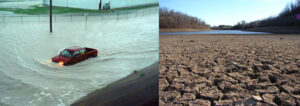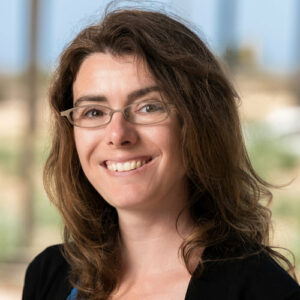Drought and super rain are the new normal – UC Cal’s Dr. Samantha Stevenson with 2 new science results. War in Ukraine’s environmental costs – and a new vision for climate action, from author/journalist Nikolas Kozloff.
Listen to or download this Radio Ecoshock show in CD Quality (57 MB) or Lo-Fi (14 MB)
MEGADROUGHT AND MEGA-RAINS – SAMANTHA STEVENSON

As we are going, megadrought will be so common in some places that will be the new normal. In fact, scientists say, we may already be there. Other parts of the world are changing toward extreme rains and floods, over and over again. Worst of all in a super-heated future, extreme events like wildfires and floods can follow one another in quick succession, like a one-two punch. This is the new world we make by burning fossil fuels.
We can find it all in new science from University of California Assistant Professor and researcher Dr. Samantha Stevenson, working with a small team of expert co-authors.
Listen to or download this 25 minute interview with Samantha Stevenson in CD Quality or Lo-Fi

Samantha was also a project scientist at the National Center for Atmospheric Research. NCAR, as it is known, works to establish climate impacts, including fires. Recently, staff at NCAR were evacuated due to a nearby wildfire. It was called the NCAR fire. Is that ironic?
But we go to a new paper led by Stevenson, published March 14, 2022 in the prestigious journal Proceedings of the National Academy of Sciences. The title is “Twenty-first century hydroclimate: A continually changing baseline, with more frequent extremes”.
How can we know changes in major systems, when the “normal” baseline changes so fast? That is one of the problems addressed in this paper. If a region is in a megapluvial period (decades of wetter mean precipitation) – how would a single event show up? Compared to the new developing background as the world warms, how extreme will the next extremes be, say in 2030, or 2060? To put it another way, how do we know if even drier weather is expected, when drought has been common for decades?
almost two thirds of Earth’s habitable land surface will experience either drought or extreme wetting
This team finds almost two thirds of Earth’s habitable land surface will experience either drought or extreme wetting. In some cases, those could be permanent changes, at least in human time scales. This PNAS paper finds megadrought already developing in the southern United States/northern Mexico, the Amazon, the majority of Europe, and southern Africa. But long-lasting drought may appear in other places, in coming decades, including some surprises, like in Northern Canada.
The authors found the appearance of some megapluvial events might be delayed until later in this century, while megadrougths are already here. The paper says:
“…the emergence of the temperature signal appears to proceed more rapidly than that of precipitation, which in the near term could imply that so-called “hot droughts” might be increasing in frequency. Alternatively, the “delayed” response of precipitation signals could mean that regions where wet conditions are expected to emerge might temporarily experience megadrought due to the near-term temperature trend.”
On our current greenhouse gas path, the new normal for almost a third of settled Earth, is really a new extreme pattern. In fact, this paper says: “the entire late 21st century is identified as a single large event.”
FIRE AND FLOOD
We could talk about Australia, Southern Europe, many places, but in the interview we examine a classic case of extremes, with Samantha’s latest paper, released April 1st: “Climate change increases risk of extreme rainfall following wildfire in the western United States“. That paper is led by Danielle Touma at NCAR and Stevenson is a co-author.
In 2021, my home province of British Columbia shared the intense heat dome and multiple giant wildfires found in the Western states. Then just 2 months after the provincial fire emergency was lifted in September, we were hit with unbelievable amounts of rain. All highways and rail connections to the rest of Canada were cut off by landslide and floods. That is what we are facing in coming decades.
According to the Press Release for this paper published April 1st 2022 in Science Advances:
“Touma et al. found that, under a high emissions regime often referred to as the “business as usual” scenario, California, Colorado, and the Pacific Northwest could all experience robust increases in the likelihood of these combined extreme weather events. The Pacific Northwest could be hit especially hard, with about 90% of the region’s simulated future extreme fire weather events followed by at least one extreme rainfall event within 6 months – and often several events in the years after a fire – according to the model results.”
RAIN/FLOOD SUSCEPTIBILITY LASTS UP TO 8 YEARS AFTER THE FIRE
From the Science Advances paper:
“These events are often sudden and difficult to predict—and can sometimes be deadly and destructive in populated areas. Hydrologically relevant effects within fire footprints can linger for up to a decade – incurring the risk of debris flows for up to 3 to 5 years following fire as the ground cover and fine roots recover, and the risk of flash floods for up to 5 to 8 years following fire as the soil returns to normal absorbance and vegetation regrowth.”
People may have forgotten the fire a few years before, and not realize the unusual flood damage is partly a result of previous fire damage.
IT’S WORSE IF EXTREME RAINS COME WITHIN 1 OR TWO YEARS…
Touma et al write:
“Meanwhile, more severe regional impacts can occur when extreme rainfall occurs within 1 or 2 years after a wildfire, compounding the consequences of each and resulting in a higher impact event, especially if recovery efforts from the previous wildfire are still ongoing.”
CASE EXAMPLES FROM THE PAPER:
“As a recent case, debris flows in Glenwood Canyon, Colorado in July 2021 occurred following heavy rainfall over the areas burned by the Grizzly Creek Fire in the previous year. These debris flows led to severe damages to infrastructure and roadways, shutting down a vital east-to-west connector across the Rocky Mountains. Post-fire rainfall events within shorter time frames have also had deadly consequences:
In January 2018, Montecito in southern California experienced debris flows after a short but intense storm fell over the footprint of the December 2017 Thomas Fire, leading to 23 fatalities and $200 million in property damage.
Farther north, in Okanogan County, Washington, a severe summer storm in 2014 caused mudslides and flash floods within the 1-month-old Carlton Complex Fire footprint, destroying homes and blocking major highways. Understanding the risk of these linked events in a changing climate is therefore crucial for informed emergency
management and community adaptation.”
A key piece of companion science: J. T. Abatzoglou, et al. “Global patterns of interannual climate–fire relationships”. Glob. Chang. Biol. 24, 5164–5175 (2018).
The American government also has a fact sheet on floods after fires here, and here.
Are compound fires and floods accidental, being just more likely because many extremes are more likely with warming? Could there be an underlying relationship? Is nature seeking a kind of balance? Do masses of aerosols tossed upward by fires then form the nuclei for raindrops?
Weather extremes are a feature of climate disruption. We are bound to get more extreme rainfall events, especially as the atmosphere can hold about 7 percent more water vapor for every degrees C. of warming. So it seems inevitable that extreme rains will find wildfire-burned areas.
FIRE PLUS FLOOD, COMPOUND DISASTERS IN BOTH HEMISPHERES
We have seen extreme and large wildfires in Australia and British Columbia, that were followed by record-setting rains and floods. In a recent show, I spoke about that observed combination of fire and flood in Australia with Andrew Sullivan of CSIRO.
We know extreme rains do worse damage when they encounter landscapes already burned out by wildfires. In fact, the impacts of post-fire extreme rain travels much further than the fire zone, down into the watershed below.
California might as well get ready for more and more of these compound strikes. What does it mean to live in such an unstable climate, where sequences of disaster follow one another, sometimes before people recover from the first one?
This new paper seems part of a developing awareness of relationships. All the pieces of the climate shift together. For example, Climate researchers at the Helmholtz Centre for Environmental Research (UFZ) just published a paper on “Two extremes at the same time… how.. droughts and heat waves will occur together”.
DROUGHT IN EUROPE: Earth’s Future Research Article Open Access, “The 2018–2020 Multi-Year Drought Sets a New Benchmark in Europe” The new paper led by Oldrich Rakovec, and published March 15 this year, has this surprising news for us:
“Plain Language Summary
This manuscript demonstrates that the 2018–2020 multi-year drought event constitutes a new benchmark in Europe, with an unprecedented level of intensity over the past 250 years. What makes this event truly exceptional compared with past events is its temperature anomaly reaching +2.8 K. This finding provides new evidence that the ongoing global warming exacerbates current drought events. The key message of this study is that the projected future events across the European continent will have a comparable intensity as the 2018–2020 drought but exhibit considerably longer durations than any of those observed during the last 250 years. Our analysis also shows that these exceptional temperature-enhanced droughts significantly negatively impact commodity crops across Europe.”
And check out this Scientific American article on Samantha Stevenson’s work: “Double Disaster: Wildfires Followed by Extreme Rainfall Are More Likely with Climate Change – These events can cause devastating landslides and flash floods” By Andrea Thompson on April 1, 2022.
===================================================================
CLIMATE EMERGENCY AND WAR – NIKOLAS KOZLOFF
In war, humans count the war dead, buildings and roads destroyed. But we are not alone on this planet. Plants and animals are also casualties of war. So is the atmosphere. We don’t hear about that – except from a few voices, like author and journalist Nikolas Kozloff.
Nikolas spent years not just studying South America, but living there. With his doctorate in Latin American history from Oxford, we could call him Dr. Kozloff He published on Hugo Chavez and oil politics in Latin America, and the book “Revolution! South America and the Rise of the New Left”. It’s a story which still continues with recent Leftist wins in countries like Chile. But in 2014, Kozloff turned toward Ukraine and the ancient environment of the Black and Azov seas. He traveled there four times in recent years, and just published a blog roundup called “Climate Emergency and War”.

Author/journalist Nikolas Kozloff
Listen to or download this 24 minute interview with Nicholas Kozloff in CD Quality or Lo-Fi
Nikolas and I last spoke on Radio Ecoshock in 2010 about the South American perspective on the 2010 climate talks in Cancun Mexico. So long ago. I knew him as an expert on South America, from the deep Amazon to oil politics in Venezuela. Kozloff tells us how he turned toward the eco-region around the Ukraine, and revolutionary hopes there. In 2016, he published the book “Ukraine’s Revolutionary Ghosts”.
Find Kozloff’s 2014 Article On Putin, Ukraine, and Environment here in the Huffington Post.
THE FOSSIL ANGLE: GAS RESERVES IN BLACK SEA AND AZOV SEA
This is seldom reported in media. Kozloff writes in 2014:
“Put together, the Black Sea and Azov Sea shelf are thought to contain around 57 trillion cubic feet of gas. Prior to Putin’s annexation of Crimea, Ukrainian state-owned energy company Chornomornaftogaz owned oil and gas fields in the Black and Azov Seas in addition to 13 offshore platforms.
Following his seizure of Crimea, Putin nationalized Chornomornaftogaz. Furthermore, by annexing Crimea the Kremlin may lay claim to a vast offshore maritime zone along with the rights to exploit underwater Black and Azov Sea resources to the tune of trillions of dollars. Losing the Crimea, then, represented not only a crippling diplomatic defeat for Ukraine but also a devastating economic loss which set back Kiev’s hopes for energy independence.
Prior to Russia’s seizure of the Crimea, western energy giants such as ExxonMobil and Shell had developed joint plans with Chornomornaftogaz to exploit offshore Black Sea hydrocarbon assets. Following the recent fighting, however, Ukraine’s foreign partners have pulled out. Perhaps, Russia’s state-owned Gazprom can fill the energy vacuum, though mounting sanctions on Moscow could slow the Kremlin’s plans by cutting off western financing and technology.”
In our interview, we hear about life in the little-known Sea of Azov, and the famous Black Sea, including a special dolphin there.
THIS IS A FOSSIL FUEL WAR
The Ukraine’s leading climate scientist, Svitlana Krakovska was working to finalize a report for the Intergovernmental Panel on Climate Change (IPCC) when bombs started falling around her. She immediately said: “This is a fossil fuel war“.
But the climate impacts of military are global. The U.S. military is the largest single institutional fossil fuel burner and polluter. All this plane traffic to Eastern Europe, tanks and trucks running round, I see it as more pointless damage to the atmosphere. But the Paris Accords and the IPCC don’t even count military emissions, like we can pretend they don’t matter to nature either. Could we bump up global warming just from war and the whole dark game of militarism?
Carroll Muffett, President of the Center for International Environmental Law, and a lead author of a letter from 900 international law groups, just said: “Continued reliance on fossil fuels is as destabilizing for global peace as it is for the global climate.”
When you think about it, most of us lived under an organized suicide-prevention scheme called Mutually Assured Destruction or MAD. If they launch nuclear missiles, we do too. Everyone and everything goes extinct in a nuclear winter. This civilization is built on a tendency for mass suicide. That doesn’t look good for us avoiding mass extinction from climate change. Do you see links between MAD militarism and climate survival?
Nikolas Kozloff also published a “Revolutionary Handbook” “about how to bring about non-violent revolutionary change”. If we de-fund fossil fuels, and go with localized renewable resources, is that revolutionary, and do you think big government – everywhere – knows and fears that change?
OTHER RESOURCES
CLIMATE ACTION DURING CRISIS
from Alex Smith
We get a new insight from Nikolas Kozloff in this interview. Over the past two or three years climate activism has been stalled by the pandemic, and now public attention on the Ukraine, not to mention inflated prices at home. We are all stunned by these developments, and it was natural to think “Well, we have to wait until this clear up before we can get momentum going in the climate campaign”.
But now we know a decade of multiple disruptions loom ahead of us. And this is the last decade we have to determine what will happen to the world’s climate after 2050. Scientists on this program explained the next years of extreme climate events are already determined by our past emissions. Cutting back and going green can’t change that. Our actions now, though, can help future decades, including the times of our children and grandchildren, in a big way. We can steer away from a catastrophic future by our actions now.
As Kozloff said, we needed to retain the work-from-home, don’t drive around, cut consumption of useless products developed during the pandemic. We needed to use that emergency to reduce our emissions. Sadly, most Western-style consumers want to go back, and want to make up for lost time with even more international tourist flights burning carbon, even more stuff. It is that rush to demand, after production was cut during the pandemic, that is partly causing current steep rises in prices.
Now the conflict in Ukraine has demonstrated how Europe depends on Russian fossil fuels. There is a lot of talk about ramping up renewables to fill that gap, and we hope that happens. This is another example of working WITH the crisis to build a more sustainable economy.
The old normal is not coming back. There isn’t going to be a peaceful break without weather extremes and human social twists, a time when we can hang banners and celebrate in climate camps. There isn’t going to be the slow process of social process to get ponderous legislative change. We need a new climate action that is ready to use every stress point to reduce greenhouse gases going into the atmosphere, and to save natural systems while they are still functioning. Through war, storms, and tears, smart and dedicated minds all over the world need to coordinate the new climate action.
Maybe the climate crisis can begin to thaw relations, as science did in the Cold War? Maybe, some day, in the fires, heat, weird cold snaps and hurricanes, humans will agree to set aside differences, and work together, as a species on a small planet. That is the small hope we have.
My thanks to all the listeners who support this show. I’m Alex, for Radio Ecoshock.
Pingback: This week in nuclear news – Australia and beyond | Nuclear Australia
Pingback: Radio Adelaide » MEGADROUGHT AND MEGA-RAINS
I always look forward to reading your posts, they never fail to brighten my day and educate me in some way Thank you!